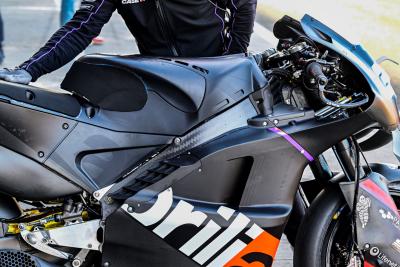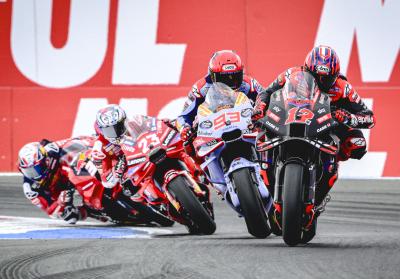Aprilia carbon fibre MotoGP frame ‘still under development’ | 2027 GPS sharing ‘better for the spectacle’
Aprilia's carbon fibre MotoGP chassis "still under development" but not ready to be raced: “It's a completely different animal".
Almost exactly a year ago, Aprilia raised eyebrows when Lorenzo Savadori was spotted at a private Misano test using a carbon fibre chassis on the factory's RS-GP MotoGP machine.
It soon turned out that Aprilia was not alone in creating a composite frame - not used in MotoGP since Ducati from 2009-2011 - with KTM wild-card Dani Pedrosa appearing with a carbon fibre chassis a few weeks later at the San Marino round.
The Spaniard took the carbon fibre to the brink of a podium, before KTM’s factory race riders also gave it a thumbs up in the Monday test, where Aprilia's race riders also tried their carbon fibre frame. It was seen again at the Valencia post-season test.
But while KTM switched all its race riders to carbon fibre for 2024, Aprilia’s latest RS-GP retains a conventional aluminium design.
“It's still under development,” Marco de Luca, Head of Vehicle Department at Aprilia Racing told Crash.net when asked about the status of the factory's carbon fibre project. “We are still thinking about it. But at the moment we prefer not to put it on the track for races.”
Although unwilling to go into details, de Luca suggested that exchanging aluminium for carbon fibre on the RS-GP is perhaps more complex than the steel trellis swap at KTM.
“KTM have a different design of the frame. A different concept and philosophy. Maybe our design, which is [unique] to our bike is - I don't want to say somehow more complex to ‘carbonise’ - but it is not a case of ‘what you do in aluminium, you do tomorrow in carbon fibre’.
“It's a completely different animal. This can be positive from the technical point of view, but it’s not something which we are ready to deploy at the moment.”
Pressed on the advantages of carbon fibre, de Luca replied:
“The obvious one is weight, but it's not just this. There are some other technical challenges and positive things we see. But also some difficulties in delivering something which is repeatable [to manufacture].
“Because you need to produce lots of frames and they need to be equal, one to the other, at less than 1%. It’s [carbon fibre] a little bit more delicate as a technology. So we need to study a little bit more.”
de Luca confirmed that by the time a carbon fibre frame is seen in public, it has undergone at least a year of development behind the scenes.
“This is something you start at least 12 months before. If not more,” he said. “Especially if it's something you are doing for the first time, like when we migrated from the aluminium swingarm to the carbon fibre.
“For Aprilia, it was a second attempt. The first they tested, they tried and they didn't arrive at the end. Then we started again the project and after one year we arrived at the track with something that even now we are still evolving.
“We are always evolving the structure, the concept, the design - even for something that you might think is now quite normal. There is still a continuous project of development for the weight, the stiffness, durability, material.
“It's very complex technology.”
2027 MotoGP rules: Fuel reduction ‘cheaper option’, GPS ‘better for the spectacle’
Quizzed on the range of performance-limiting changes to the technical rules for 2027, including a switch from 1,000 to 850cc engines, de Luca - who was involved in the discussions - said:
“For sure, we needed to something to mitigate a little bit of performance.
“Aprilia was not completely convinced about the change of engine [capacity].
“Like some of my colleagues, we were convinced that we could have something cheaper and arrive more or less at a similar result.”
Pressed on how the present engines could have had their performance substantially clipped, reducing fuel capacity was high on the list of options.
“You can reduce the energy [although] then maybe you have some headache about qualifying [spec] versus race [spec],” he said.
In terms of aerodynamics, an area of speciality for de Luca while working in Formula One, he warned:
“I've done this for years and years in Formula One: Any new regulation is just
an interruption of the development, and then you continue.”
But while he predicts it will only take “maybe a year and a half or two years” to recover the downforce lost from smaller front fairing dimensions, he stressed that the design goalposts will have been moved:
“The characteristics of the aerodynamics should be different because I don't think it makes too much sense to have exactly the same numbers as today with less power.
"So you need to work out a balance… but you need a lot of development to do that. So money spent, time spent!”
Crucially for Aprilia, which has led the MotoGP world in ‘ground effect’ - squeezing (and accelerating) the air trapped between the side of the bike and track to create downforce at high lean angles - there will be no new restrictions on side-fairing design.
“Well, it was not easy to maintain this, believe me,” de Luca admitted, hinting at Aprilia fighting its corner to retain the freedom to shape the sides of the bike.
“But at the end, [ground effect] is something that if you see the other bikes, now more or less they use the same concept.
“It's interesting to see that there are some [different] interpretations of this. Some closer to us and some not so close… Interesting.”
Turning to the future sharing of GPS data between teams, de Luca acknowledged that it’ll provide easier access to data that factories currently compile by more complicated means such as video analysis.
“We all have our, let’s say, very complex reconstruction [methods] of what the others are doing and with GPS everything is public. So it's the easiest way to do exactly what we do now but more precise and cheaper,” he said.
“I think it's better for the spectacle because at the end [if a manufacturer is behind] you can catch up more quickly, so the competition can be even more balanced.
“[Currently] we look at different parts of the circuit, different riders. We try to reconstruct. Everybody does it...”




![Johann Zarco, LCR, Honda RC213V, 2024 San Marino MotoGP, Misano, action [Gold & Goose]](https://cdn.crash.net/styles/thumbnail/s3/2024-09/GnG_1166323_HiRes.jpg?itok=vpgrU7Q4)

![Jack Miller, KTM Factory Racing, KTM RC16, San Marino MotoGP, Misano, action [Gold & Goose]](https://cdn.crash.net/styles/thumbnail/s3/2024-09/GnG_1167624_HiRes.jpg?itok=iz7mA4EQ)


![Fabio Quartararo, Monster Energy Yamaha Racing, Yamaha M1, 2024 MotoGP, Misano Test, action [Gold & Goose]](https://cdn.crash.net/styles/thumbnail/s3/2024-09/GnG_1168928_HiRes.jpg?itok=fcYSole_)
![Toprak Razgatlioglu, ROKiT BMW Motorrad, BMW M 1000 RR, Magny-Cours, WorldSBK [Gold & Goose]](https://cdn.crash.net/styles/thumbnail/s3/2024-09/GnG_1165133_HiRes.jpg?itok=GD5SVNVG)

